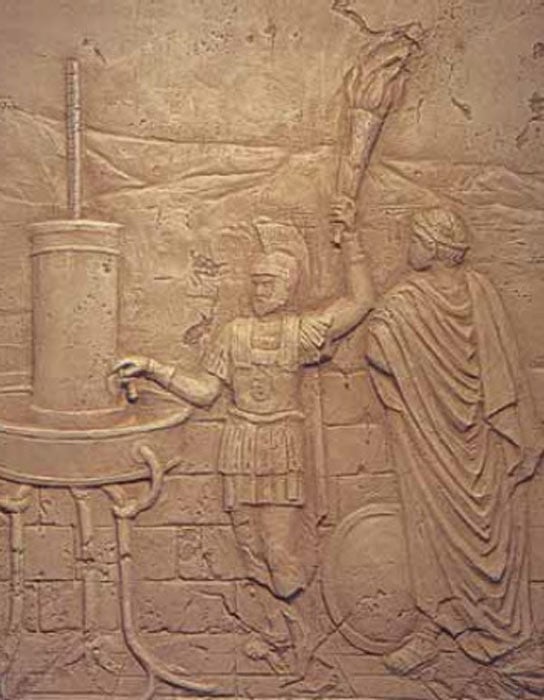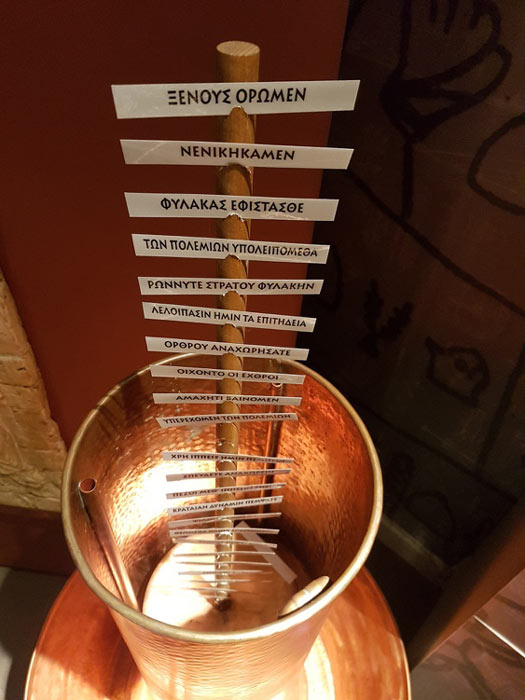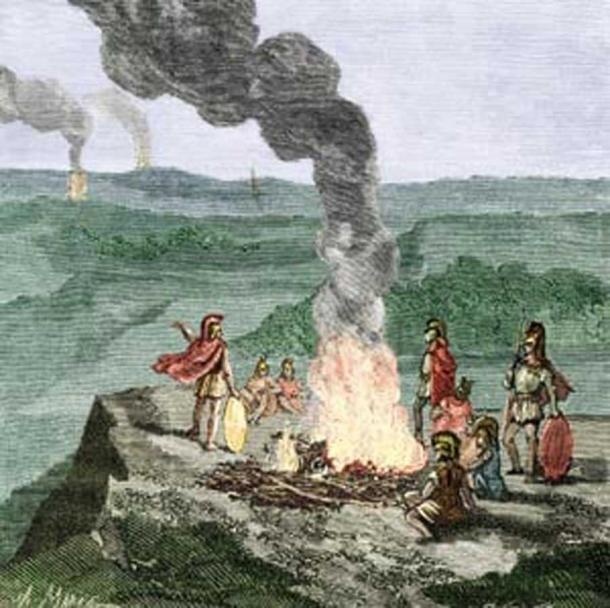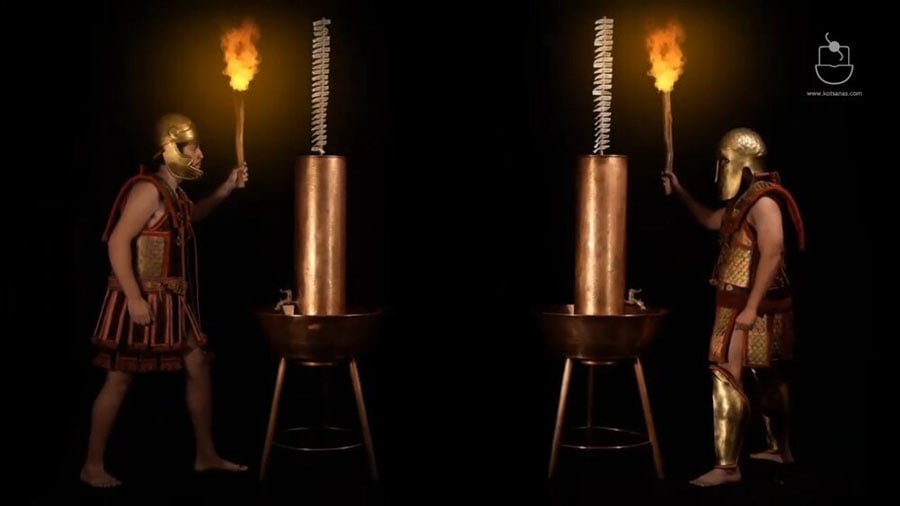The Hydraulic Telegraph of Aeneas – Long-Distance Communication of Antiquity
Advances in technology have drastically changed the way we live today compared to those of our ancient past. One type of technology that many of us may take for granted is the ability to communicate with others over long distances, or to large groups of people. A look back at ancient civilizations can give us insight today into the very first methods of long-distance communication. In 350 BC, a Greek named Aeneas invented the hydraulic telegraph, which was a means of quickly communicating important, fairly detailed information over long distances.

A relief of the Greek hydraulic telegraph of Aeneas, depicting one half of a telegraph system. (Public domain)
Aeneas – Inventing the Hydraulic Telegraph
Aeneas was a Greek writer who focused on military history, strategy, communications. He was one of the first authors to provide a guide on military communications, which were important for ensuring that any society had the ability to anticipate possible invasions, and to communicate strategy and tactics back and forth between groups.
- Ancient Greek Science and Technology – From Antikythera to Pharos
- Primeval Communication and the Beat of the Drum
Aeneas was frustrated by the limitations placed on communications via torches and beacons. Torches allowed some messages to be conveyed. They could, for example, indicate danger, or communicate that an objective had been accomplished, but they could not send messages with any level of detail or description. Essentially, they could communicate that something had occurred, but there was no way to communicate what had occurred.

4th century BC hydraulic telegraph at the Thessaloniki Technology Museum. (Gts-tg / CC BY-SA 4.0)
Ins and Outs of the Hydraulic Telegraph
Aeneas therefore developed the hydraulic telegraph in an attempt to overcome these obstacles. The telegraph involved a system of water-filled vessels containing rods that contained agreed-upon messages (such as “horsemen entering the country” or “ships”). The two groups who wished to communicate would both have an identical set of supplies, and would be positioned far away from one another, but still within a line of sight, usually upon a hill.
When one party wanted to send a message to the other, they would raise a torch. Upon seeing the torch raised, the second party would raise their torch to confirm they were prepared to receive the message. When the initial sender lowered his torch, both sides would simultaneously pull the plug from the bottom of the water-containing vessel.
For #WorldPostDay here is an attempt to reconstruct the ancient Greek hydraulic water telegraph, which was combined with torch flashes, as described by Aeneas the Tactician in the 4th century BCE. pic.twitter.com/0D4uv8HAU7
— @edithmayhall (@edithmayhall) October 9, 2018
As the water drained, different messages on the rod would be revealed. When the intended message reached the top, the initial sender would again light his torch, signaling that the receiver should re-plug the vessel and read the message on the rod. For this to work properly, both parties had to have vessels of the same size, filled with the same volume of water, and rods containing the same messages. They also had to be very precise, starting and stopping drainage at the correct moment.

Information transmission through beacons. (Nature)
The Hydraulic Telegraph as Advanced Communication Technology
While the technology of the hydraulic telegraph seems very simple, its invention was marveled as a significant advancement in communication technology by allowing pre-determined messages to be sent long distances. In the event of an intrusion or an enemy approaching, they would only see the brief torch flashes, and would not be able to intercept the message in any way.
This development in communication was also a great advancement in military communication and strategy. Messages were sent from Sicily to Carthage during the First Punic War (264 to 241 BC) using the hydraulic telegraph, also known as a Semaphore line.
- The Ancient Invention of the Water Clock
- Aboriginal message sticks and an ancient system of communication
Through the hydraulic telegraph, the military now had the ability to communicate specific messages that allowed other groups of military personnel, as well as civilians, to better prepare for potential invasions by land or sea. This early form of long-distance communication was advanced for its time, and it paved the way for future forms of communications, which have led to the many methods we have available today.
Top image: Representation of the Hydraulic Telegraph of Aeneas. Source: Kotsanas Museum of Ancient Greek Technology
By M. R. Reese
References
No name. No date. “The ''hydraulic telegraph'' of Aeneas – Museum of Ancient Greek Technology” in Kotsanas Museum of Ancient Greek Technology. Available at: http://kotsanas.com/gb/exh.php?exhibit=1201002
Norman, J. M. No Date. “Polybius Recorded the Invention of the Hydraulic Telegraph” in History of Information. Available at: http://www.historyofinformation.com/expanded.php?id=1612


















Comments
Sounds hoaky. Other simpler ways would work better. Arrows with messages, string lines, colored baloons, etc.
Nobody gets paid to tell the truth.
Fascinating technology. To answer Rod and Guillaume, semaphores or a torch alphabet could also be read by the enemy, whereas these messages could not. So this was better technology.
Water can drain slow or fast depending on the size of the hole. It couldn't be too fast though, because the recipient need time to put the plug back. Obviously things could go wrong (torch goes out or won't light). But overall this was ingenious.
As for the messages being too slow, not really. If the signallers were miles or kilometers apart they would have enough time to respond. Remember, the enemy would have been on foot, horse chariot. Even if the enemy cavalry was galloping, they can't cover 10 miles or kilometers as fast as a signal or even a torch or two waved frantically.
The Punic wars were mentioned, and the system was used successfully there apparently, so it was effective enough.
Ingenious, fascinating technology by our forebears.
--
Robertus
And then, Native Americans supposedly were able to communicate fairly complex messages by smoke signals, I’ve no idea of the time frame though. Or, maybe that’s just in the movies, havent seen any real evidence.
Who knew that information pipelines existed so far back in ancient history?
The way I see it, this technology easily rivals the dial-up internet of the early 90s.
I still use smoke signals so they've pretty much got me beat with this technology..
Pages